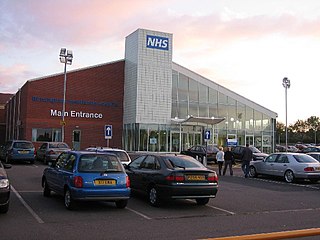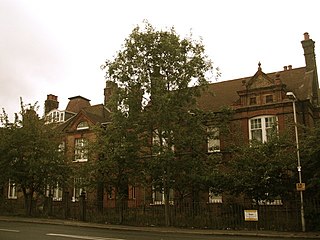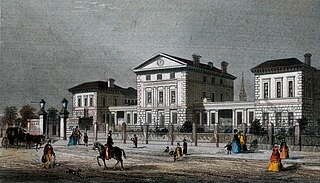
Whittington Hospital is a district general and teaching hospital of UCL Medical School and Middlesex University School of Health and Social Sciences. Located in Upper Holloway, it is managed by Whittington Health NHS Trust, operating as Whittington Health, an integrated care organisation providing hospital and community health services in the north London boroughs of Islington and Haringey. Its Jenner Building, a former smallpox hospital, is a Grade II listed building.

Fulwood ward—which includes the districts of Fulwood, Lodge Moor, and Ranmoor—is one of the 28 electoral wards in the City of Sheffield, England. It is located in the far western part of the city and covers an area of 23.2 km2. The population of this ward in 2011 was 18,233 people in 6,476 households. Fulwood ward is one of the five wards that make up the Sheffield Hallam Parliamentary constituency. In the 2004 local elections John Knight, Janice Sidebottom, and Andrew Sangar, all Liberal Democrats, were returned as councillors for the newly drawn ward. The current Member of Parliament is Labour's Olivia Blake.

The Royal Hallamshire Hospital is a general and teaching hospital located in Sheffield, South Yorkshire, England. It is in the city's West End, facing Glossop Road and close to the main campus of University of Sheffield and the Collegiate Crescent campus of Sheffield Hallam University. The hospital is run by the Sheffield Teaching Hospitals NHS Foundation Trust.

Ali Maow Maalin was a Somali hospital cook and health worker from Merca who is the last person known to have been infected with naturally occurring Variola minor smallpox. He was diagnosed with the disease in October 1977 and made a full recovery. Although he had many contacts, none of them developed the disease, and an aggressive containment campaign was successful in preventing an outbreak. Smallpox was declared to have been eradicated globally by the World Health Organization (WHO) two years later. Maalin was subsequently involved in the successful poliomyelitis eradication campaign in Somalia, and he died of malaria while carrying out polio vaccinations after the re-emergence of the poliovirus in 2013.
The Sheffield Teaching Hospitals NHS Foundation Trust is an NHS foundation trust in Sheffield, England. Founded in 2001 and awarded foundation status in 2004, the trust covers Sheffield's two major adult hospitals, the Northern General Hospital and the Royal Hallamshire Hospital, as well as the specialised Charles Clifford Dental, Jessop Wing and Weston Park hospitals. The chief executive of the trust is Kirsten Major, and the medical director is Dr David Hughes.

The Northern General Hospital is a large teaching hospital and Major Trauma Centre in Sheffield, England. Its departments include Accident and Emergency for adults, with children being treated at the Sheffield Children's Hospital on Western Bank. The hospital is managed by the Sheffield Teaching Hospitals NHS Foundation Trust.

Highlands Hospital was a hospital in Winchmore Hill, in the London Borough of Enfield. The hospital closed in 1993, and the site was developed for residential accommodation, although many of the original buildings remain. The site is designated a conservation area and the former ambulance station is a grade II listed building.

In health care facilities, isolation represents one of several measures that can be taken to implement in infection control: the prevention of communicable diseases from being transmitted from a patient to other patients, health care workers, and visitors, or from outsiders to a particular patient. Various forms of isolation exist, in some of which contact procedures are modified, and others in which the patient is kept away from all other people. In a system devised, and periodically revised, by the U.S. Centers for Disease Control and Prevention (CDC), various levels of patient isolation comprise application of one or more formally described "precaution".

Crimicar Lane Hospital and Sanatorium was an isolation hospital for sufferers of smallpox and tuberculosis in the City of Sheffield, England. It was situated in the suburb of Lodge Moor. The hospital opened in 1902 and closed in 1956.
The 1947 New York City smallpox outbreak occurred in March 1947 and was declared ended on April 24, 1947. The outbreak marked the largest mass vaccination effort ever conducted for smallpox in America. Within three weeks of the discovery of the outbreak, the U.S. Public Health Service, in conjunction with New York City health officials, had procured the smallpox vaccine and inoculated over 6,350,000 adults and children. Of that number, 5,000,000 had been vaccinated within the first two weeks. The rapid response was credited with limiting the outbreak to 12 people, 10 of whom recovered, while 2 died.

King's Cross Hospital, often shortened to King's Cross is a hospital in Dundee, Scotland. It is managed by NHS Tayside.

Joyce Green Hospital was a hospital near Dartford, Kent, England. It opened in 1903 as an isolation hospital. In later years it was a training hospital. The hospital was closed in 2000 and the buildings were demolished. The greenspace where the hospital used to stand is known as Joyce Green.

Heartlands Hospital is an acute general hospital in Bordesley Green, Birmingham, England. It is managed by University Hospitals Birmingham NHS Foundation Trust.
Catherine-de-Barnes Isolation Hospital was a specialist isolation hospital for infection control in Catherine-de-Barnes, a village within the Metropolitan Borough of Solihull in the English county of West Midlands.

Westhulme Hospital, also known for some time as Westhulme Fever Hospital, was an institution in Oldham, England. At one time a hospital for infectious diseases, it later became a site used by several health-related organisations.

Coppetts Wood Hospital was a hospital in Muswell Hill, London. It was managed by the Royal Free London NHS Foundation Trust.
Lodge Moor was a British military camp based near Redmires Reservoirs, Sheffield, that was best known for housing prisoners of war during World War II. It held approximately 11,000 at its peak, mostly Germans. It was established in World War I for training purposes.

The Western Community Hospital is a health facility in William Macleod Way in the Shirley / Millbrook area of Southampton, Hampshire, England. It is managed by the Southern Health NHS Foundation Trust.

A fever hospital or isolation hospital is a hospital for infectious diseases such as scarlet fever and smallpox. Their purpose is to treat affected people while isolating them from the general population. Early examples included the Liverpool Fever Hospital (1801) and the London Fever Hospital (1802). other examples occurred elsewhere in the British Isles and India

The Edinburgh City Hospital was a hospital in Colinton, Edinburgh, opened in 1903 for the treatment of infectious diseases. As the pattern of infectious disease changed, the need for in-patients facilities to treat them diminished. While still remaining the regional centre for infectious disease, in the latter half of the 20th century the hospital facilities diversified with specialist units established for respiratory disease, ear, nose and throat surgery, maxillo-facial surgery, care of the elderly and latterly HIV/AIDS. The hospital closed in 1999 and was redeveloped as residential housing, known as Greenbank Village.

















